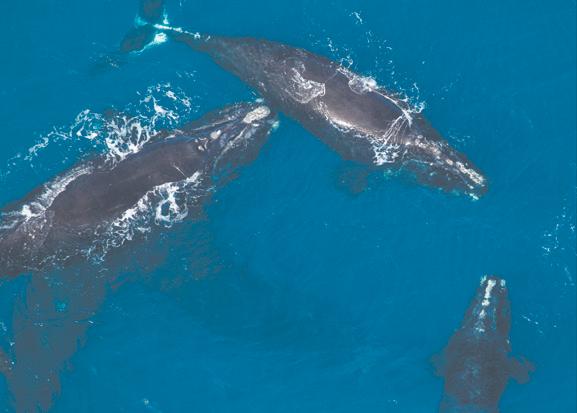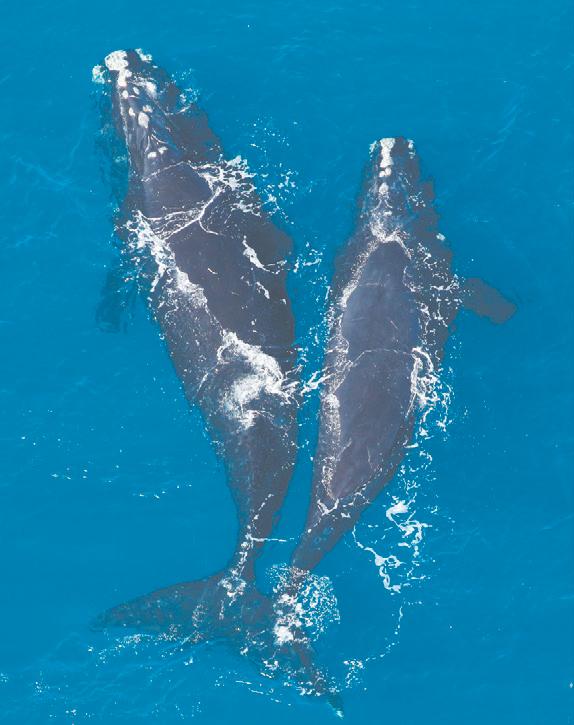
3 minute read
Right Whale Season Info
Right Whale Season in Coastal Waters
In late fall and early winter, pregnant right whales make their way south to give birth and nurse their young in the warm waters off the coasts of South Carolina, Georgia and northern Florida. This is the only known calving area for the endangered North Atlantic right whales. Right now there are only around 450 of these animals left on the planet. The loss of even one puts them at greater risk of extinction.
Advertisement
Approximately a third of all known right whale mortalities are a result of vessel collisions or entanglement in fishing gear. Here's how you can help: 1. Stay at least 500 yards away from right whales! It’s the law! 2. Operate your vessel at a slow, safe speed of 10 knots or less in areas where right whales are known to occur. 3. Move away slowly if a right whale approaches you. 4. Wear polarized sunglasses and stay alert. 5. Avoid boating during times of poor visibility (fog, night, etc.) 6. Know how to properly identify right whales and immediately report dead, injured, or entangled whales to the U.S. Coast Guard via marine radio VHF Ch 16 or call the NOAA Fisheries Service Stranding Hotline at (877) 942-5343.
This group of eight right whales was spotted socializing 30 miles east of Jekyll Island on Feb. 15, 2018. Among the group was whale #1281 (left), a calving female nicknamed Punctuation and at least 37 years old, and #3333 (top), a 15-year-old male. Photo by Sea to Shore Alliance, taken under NOAA research permit 20556
Report a Right Whale Sighting
You can help collect vital information. Reporting sightings helps save this endangered species by alerting mariners to their presence.
To report, hail the U.S. Coast Guard on VHF Channel 16, or call (877) WHALE-HELP (in waters from Florida to North Carolina).
Right whale #3940, a 9-year-old female (left), and a smaller right whale (right; it has not yet been cataloged and is likely 1 or 2 years old) socialize 30 miles east of Jekyll Island on Feb. 15, 2018. Photo by Sea to Shore Alliance, taken under NOAA research permit 20556
Is it a North Atlantic Right Whale?

• White patches (callosities) on head • Distinctive V-shaped blow • Smooth edges on tail flukes • Paddle-shaped black flippers • No dorsal fin • No throat grooves • Black robust body
What Information Should You Report?
• Your name and contact information • Date and time of sighting • Where you were (vessel, land) • Number of whales sighted • Any behavior observed • Are you sure it was a right whale? • Describe what you saw, in detal
If Possible, Take Photos or Video and Report This Information as Well:
• Did you see a visible spout during exhale? • Do the flukes (tail) come out of the water on a deep dive? • Does it have bumps on it's head and what color are they? • How long is the whale (how many feet? Compared to boat?) • If entangled, is the whale free-swimming or anchored? • Give specific info on key body parts (both flippers, tail and mouth) and any gear observed (buoys and line colors, buoy numbers, etc.)
Is the Whale Dead, Injured or Entangled?
If possible, keep dead or injured whales in sight and report immediately. Do not attempt to remove fishing gear! There is a team of experts who disentangle whales.



